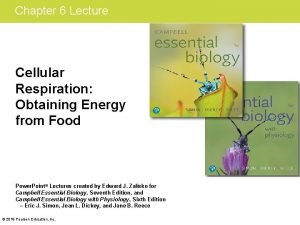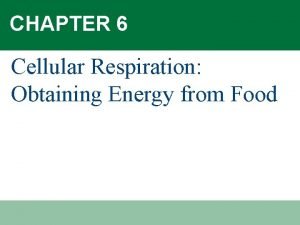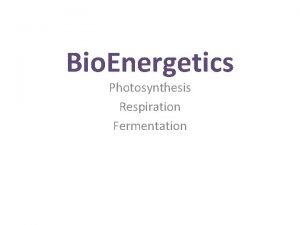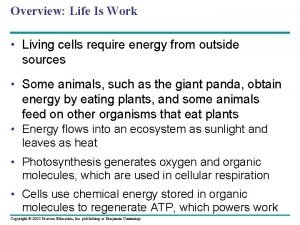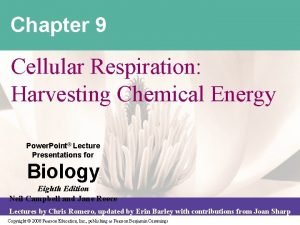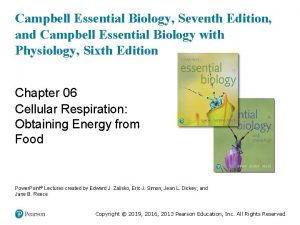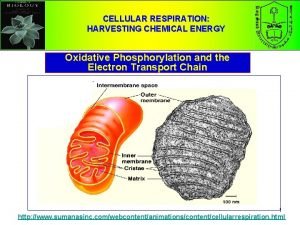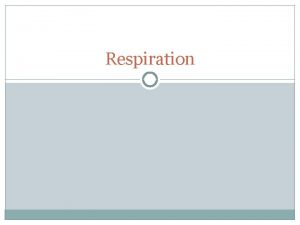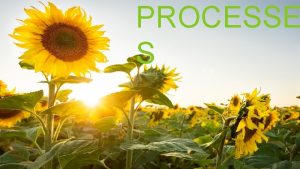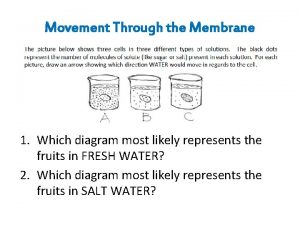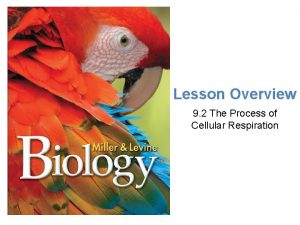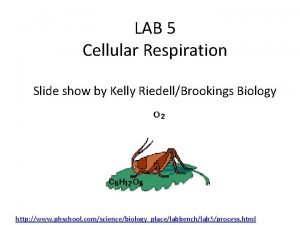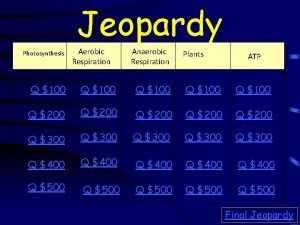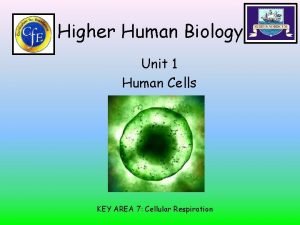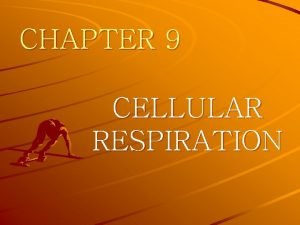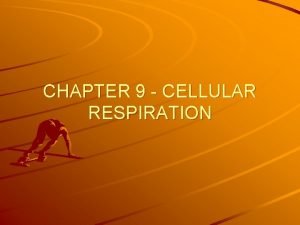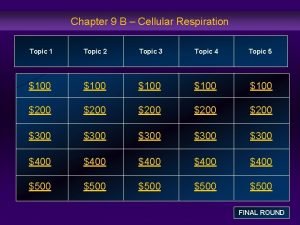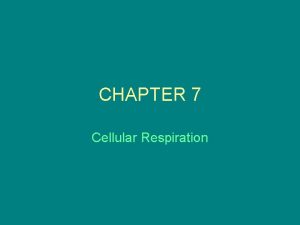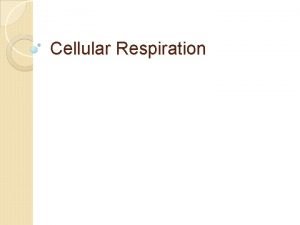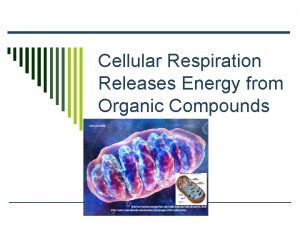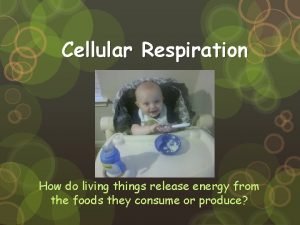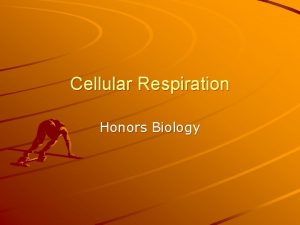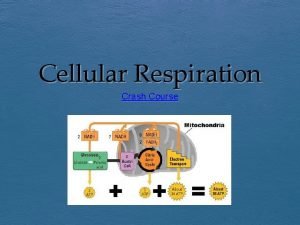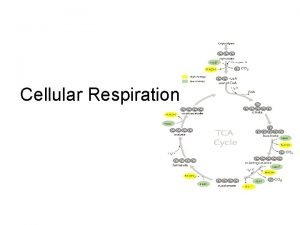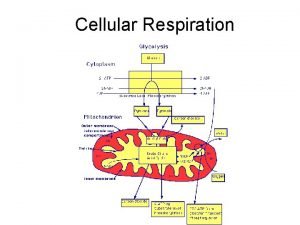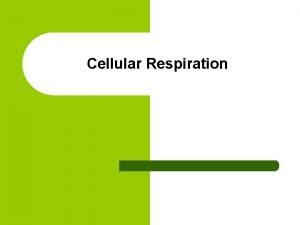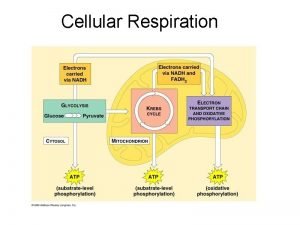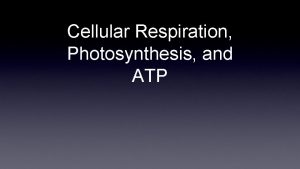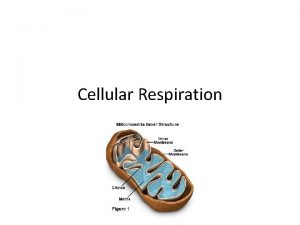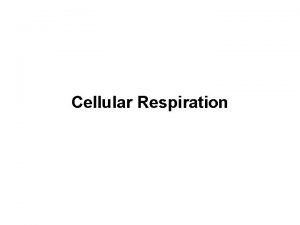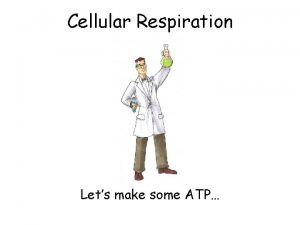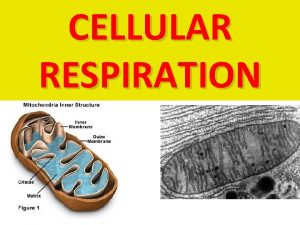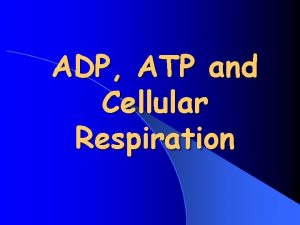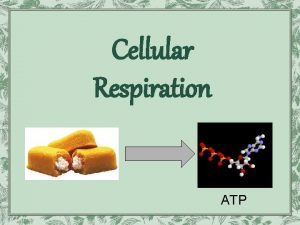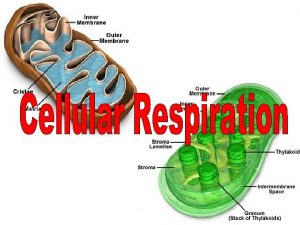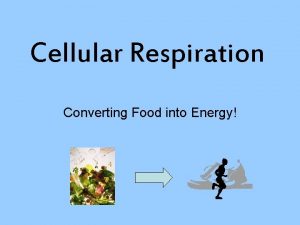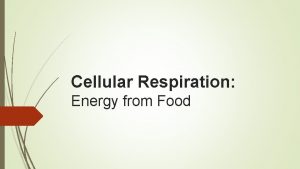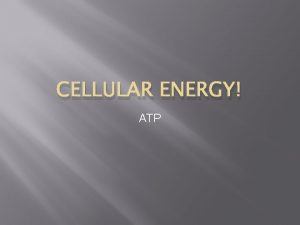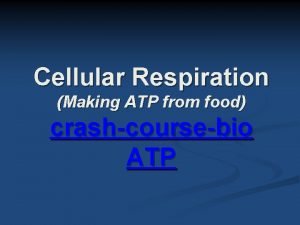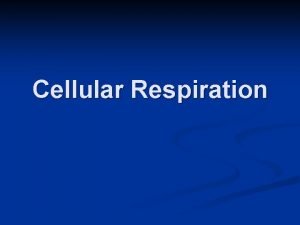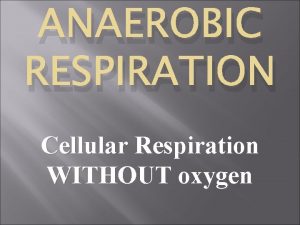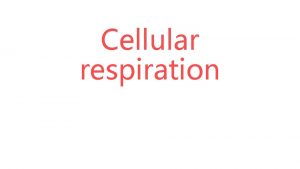Cellular Respiration Food energy to ATP 10292020 ATP













































- Slides: 45

Cellular Respiration Food energy to ATP

10/29/2020

ATP Adenosine Tri-Phosphate (ATP) Adenosine Ribose Sugar 3 Phosphates 29 October 2020

29 October 2020

Explain: Where do our cells get energy? 6 -C sugars are the MAJOR source of energy for cell What type of macromolecule are 6 -C sugars? Carbohydrates Cells break down glucose a 6 -C sugar to make ATP “energy” 29 October 2020

Overall Chemical Process C 6 H 12 O 6 + 6 O 2 6 CO 2 + 6 H 2 O + usable energy (36 ATP) 29 October 2020

Cellular Respiration (3 -stages) Glycolysis Krebs Cycle (Citric Acid Cycle) Electron Transport Chain (ETC) Glucose Glycolysis Krebs cycle Fermentation (without oxygen) 29 October 2020 Electron transport Alcohol or lactic acid

Flowchart Section 9 -2 Cellular Respiration Glucose (C 6 H 1206) + Oxygen (02) Glycolysis Krebs Cycle Electron Transport Chain Carbon Dioxide (CO 2) + Water (H 2 O) + ATP

29 October 2020

Glycolysis: Figure 9– 3 Glycolysis Step 1 Glucose 2 Pyruvic acid To the electron transport chain

Figure 9– 3 Glycolysis Section 9 -1 Glucose 2 Pyruvic acid To the electron transport chain

Figure 9– 3 Glycolysis Section 9 -1 Glucose 2 Pyruvic acid To the electron transport chain

Where Cytoplasm NO O 2 required Energy Yield net gain of 2 ATP at the expense of 2 ATP 6 -C glucose TWO 3 -C pyruvates Free e- and H+ combine with organic ion carriers called NAD+ NADH + H+ (nicotinamide dinucleotide) 29 October 2020

Summary In Glucose (6 -C) 2 ATP 29 October 2020 Out 2 pyruvate; 2(3 -C) 2 NADH a net of 2 ATP

29 October 2020

The Krebs Cycle Section 9 -2 Citric Acid Production Mitochondrion

Figure 9– 6 The Krebs Cycle Section 9 -2 Citric Acid Production Mitochondrion

Breakdown of Pyruvic Acid Where mitochondria Pyruvate (3 -C) Acetic acid (2 -C) 3 rd C forms CO 2 Acetic acid combines with Coenzyme A to form ACETYL-Co. A 29 October 2020

Summary In Pyruvate NAD Co. A 29 October 2020 Out CO 2 (as waste) NADH Acetyl-Co. A

What is releasing Energy with O 2? Aerobic respiration Where In mitochondria 29 October 2020

Second Step: Citric Acid Cycle (Krebs Cycle) Where Mitochondrial matrix Energy Yield 2 ATP and more e. Acetyl-Co. A (2 -C) combines with 4 -C to form 6 -C CITRIC ACID Citric Acid (6 -C) changed to 5 -C then to a 4 -C Gives off a CO 2 molecule NAD+ and FAD pick up the released e. FAD becomes FADH 2 NAD+ becomes NADH + H+ Cycle ALWAYS reforming a 4 -C molecule 29 October 2020

Krebs Cycle 29 October 2020

The Krebs Cycle Section 9 -2 Citric Acid Production Mitochondrion

Figure 9– 6 The Krebs Cycle Section 9 -2 Citric Acid Production Mitochondrion

ETC Where inner membrane of mitochondria Energy Yield Total of 32 ATP O 2 combines with TWO H+ to form H 2 O Exhale - CO 2, H 2 O comes from cellular respiration 29 October 2020

Electron Transport Chain Section 9 -2 Electron Transport Hydrogen Ion Movement Channel Mitochondrion Intermembrane Space ATP synthase Inner Membrane Matrix ATP Production

Summary Mitochondrion Electrons carried in NADH Pyruvic acid Glucose Glycolysis Krebs Cycle Electrons carried in NADH and FADH 2 Electron Transport Chain Mitochondrion Cytoplasm

Total ENERGY Yield Glycolysis 2 ATP Krebs Cycle 2 ATP ETC 32 ATP Total 36 ATP 29 October 2020

Another terrible video… http: //www. youtube. com/watch? v=i. Yq z_7 je. HXU 29 October 2020

What happens if NO O 2? The process STOPS 29 October 2020

Aerobic vs. Anaerobic DOES NOT require oxygen Simple fast produces smaller amounts of energy (ATP) 29 October 2020 Aerobic requires oxygen Yields large amounts of energy What is this energy molecule? ATP, ATP

29 October 2020

Releasing Energy w/out Oxygen Anaerobic Respiration NO Additional ATP is Formed Remaining energy is lost as heat NO O 2 leads to Fermentation Two Types Lactic Acid Fermentation Alcoholic Fermentation 29 October 2020

Lactic Acid Fermentation bacteria, plants and most animals After glycolysis 2 pyruvic acid changed to lactic acid Sometimes happens in your muscles, cramps-----Exercise Glucose 2 Lactic Acid + 2 ATP + Heat 29 October 2020

29 October 2020

Alcoholic Fermentation Bacteria and fungi (yeast) Ethyl alcohol and carbon dioxide are the end products Process used to form beer, wine, and other alcoholic beverages Also used to raise dough, bread Glucose 2 Ethyl alcohol + 2 CO 2 + 2 ATP + Heat 29 October 2020

29 October 2020

Cellular Respiration Review Three Main Stages Glycolysis (2 ATP) Kreb’s Cycle (2 ATP) Electron Transport Chain (32 ATP) 29 October 2020

Glycolysis: Figure 9– 3 Glycolysis Step 1 Glucose 2 Pyruvic acid To the electron transport chain

Figure 9– 3 Glycolysis Section 9 -1 Glucose 2 Pyruvic acid To the electron transport chain

Figure 9– 3 Glycolysis Section 9 -1 Glucose 2 Pyruvic acid To the electron transport chain

The Krebs Cycle: Step 2 Section 9 -2 Citric Acid Production Mitochondrion

Figure 9– 6 The Krebs Cycle Section 9 -2 Citric Acid Production Mitochondrion

Electron Transport Chain: Step 3 Section 9 -2 Electron Transport Hydrogen Ion Movement Channel Mitochondrion Intermembrane Space ATP synthase Inner Membrane Matrix ATP Production

Evaluation Cellular Respiration Concept Map 29 October 2020
 Cellular respiration obtaining energy from food
Cellular respiration obtaining energy from food Cellular respiration obtaining energy from food
Cellular respiration obtaining energy from food Photosythesis equation
Photosythesis equation Difference between an autotroph and a heterotroph
Difference between an autotroph and a heterotroph Total atp produced in cellular respiration
Total atp produced in cellular respiration Total atp produced in cellular respiration
Total atp produced in cellular respiration Oxidative phosphorylation enzymes
Oxidative phosphorylation enzymes Energy flow in cellular respiration
Energy flow in cellular respiration Chemical cycling in an ecosystem
Chemical cycling in an ecosystem Chapter 9 cellular respiration harvesting chemical energy
Chapter 9 cellular respiration harvesting chemical energy Chapter 9: cellular respiration: harvesting chemical energy
Chapter 9: cellular respiration: harvesting chemical energy Cellular respiration harvesting chemical energy
Cellular respiration harvesting chemical energy Cellular energy section 1 how organisms obtain energy
Cellular energy section 1 how organisms obtain energy Cellular respiration redox
Cellular respiration redox What is the correct equation for cellular respiration?
What is the correct equation for cellular respiration? Cellular respiration steps
Cellular respiration steps Types of respiration
Types of respiration αλκοολικη ζυμωση
αλκοολικη ζυμωση Why is cellular respiration important
Why is cellular respiration important Complimentary processes
Complimentary processes What's the equation for cellular respiration
What's the equation for cellular respiration Amloplast
Amloplast Starting materials for cellular respiration
Starting materials for cellular respiration What happens during glycolysis
What happens during glycolysis Overview of cellular respiration
Overview of cellular respiration Respiration overview
Respiration overview Cellular respiration
Cellular respiration Lab bench cellular respiration
Lab bench cellular respiration What is the word equation for cellular respiration
What is the word equation for cellular respiration Higher human biology cellular respiration
Higher human biology cellular respiration Equation for cell respiration
Equation for cell respiration Cellular respiration product
Cellular respiration product Cellular respiration releases
Cellular respiration releases Starting materials for cellular respiration
Starting materials for cellular respiration Chapter 8 section 3: cellular respiration
Chapter 8 section 3: cellular respiration Redox reaction in cellular respiration
Redox reaction in cellular respiration Cellular respiration formula
Cellular respiration formula Role of cellular respiration
Role of cellular respiration Cellular respiration releases
Cellular respiration releases Cellular respiration redox
Cellular respiration redox Glycolysis crash course
Glycolysis crash course Aerobic cellular respiration equation
Aerobic cellular respiration equation Process of cellular respiration
Process of cellular respiration Overall reaction of cellular respiration
Overall reaction of cellular respiration Where does cellular respiration take place
Where does cellular respiration take place Electron transport chain cellular respiration
Electron transport chain cellular respiration
